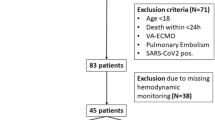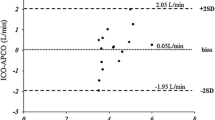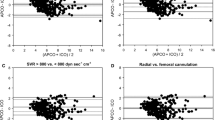Abstract
Hemodynamic monitoring plays a crucial role in the supportive treatment of critically ill patients. In this setting, the use of the pulmonary artery catheter (PAC) is a standard procedure. In this study we prospectively compare the accuracy and precision of pulmonary thermodilution (PTD) by PAC and transcardiopulmonary thermodilution (TC-PTD) in patients with cardiogenic shock following an acute cardiac event. In this prospective study 77 hemodynamic measurements were taken in 11 patients presenting cardiogenic shock (CS) treated at the medical intensive care unit of our university hospital. Hemodynamic parameters were measured simultaneously by PTD and by TC-PTD. Both techniques assessed showed a strong correlation in the obtained hemodynamic parameters. The mean bias of cardiac index between measured by PTD (CIpa) and by TC-PTD (CIpi) was 0.04 ± 0.35 L/min/m2. During intra-aortic balloon pump (IABP) counterpulsation and therapeutic hypothermia (TH) in post-resuscitation care, mean bias between CIpa and CIpi was 0.04 ± 0.36 and 0.04 ± 0.34 L/min/m2, respectively. Similarly, patients presenting mitral or tricuspid regurgitation showed interchangeable parameters. Preload parameters obtained by TC-PTD showed significant differences in patients with left ventricular ejection fraction (LVEF) <35 %, compared to patients with LVEF ≥35 %. In contrast, pulmonary arterial occlusion pressure showed no significant difference. Hemodynamic measurements by PTD and TC-PTD are interchangeable during therapy of CS, including patients IABP, TH, mitral or tricuspid regurgitation. Preload parameters measured by TC-PTD seem to be more accurate in these patients than pressure parameters of PTD to gather the acute hemodynamic situation.





Similar content being viewed by others
References
Reynolds HR, Hochman JS. Cardiogenic shock: current concepts and improving outcomes. Circulation. 2008;117:686–97.
Duvernoy CS. Management of cardiogenic shock attributable to acute myocardial infarction in the reperfusion era. J Intensive Care Med. 2005;20:188–98.
Zöllner C, Haller M, Weis M, Mörstedt K, Lamm P, Kilger E, et al. Beat-to-beat measurement of cardiac output by intravascular pulse contour analysis: a prospective criterion standard study in patients after cardiac surgery. J Cardiothorac Vasc Anesth. 2000;14:125–9.
Gödje O, Friedl R, Hannekum A. Accuracy of beat-to-beat cardiac output monitoring by pulse contour analysis in hemodynamical unstable patients. Med Sci Monit. 2001;7:1344–50.
L’E Orme RM, Pigott DW, Mihm FG. Measurement of cardiac output by transpulmonary arterial thermodilution using a long radial artery catheter. A comparison with intermittent pulmonary artery thermodilution. Anaesthesia. 2004;59:590–4.
Michard F, Alaya S, Zarka V, Bahloul M, Richard C, Teboul J-L. Global end-diastolic volume as an indicator of cardiac preload in patients with septic shock. Chest. 2003;124:1900–8.
Sakka SG, Reinhart K, Meier-Hellmann A. Comparison of pulmonary artery and arterial thermodilution cardiac output in critically ill patients. Intensive Care Med. 1999;25:843–6.
Bindels AJ, der Hoeven van JG, Graafland AD, de Koning J, Meinders AE. Relationships between volume and pressure measurements and stroke volume in critically ill patients. Crit Care. 2000;4:193–9.
Kumar A, Anel R, Bunnell E, Habet K, Zanotti S, Marshall S, et al. Pulmonary artery occlusion pressure and central venous pressure fail to predict ventricular filling volume, cardiac performance, or the response to volume infusion in normal subjects. Crit Care Med. 2004;32:691–9.
Thiele H, Zeymer U, Neumann F-J, Ferenc M, Olbrich H-G, Hausleiter J, et al. Intraaortic balloon support for myocardial infarction with cardiogenic shock. N Engl J Med. 2012;367:1287–96.
Baulig W, Schuett P, Goedje O, Schmid ER. Accuracy of a novel approach to measuring arterial thermodilution cardiac output during intra-aortic counterpulsation. J Clin Monit Comput. 2007;21:147–53.
Part 7.5. Postresuscitation support. Circulation. 2005;112(24_suppl):IV-84–8.
Lichtwarck-Aschoff M, Beale R, Pfeiffer UJ. Central venous pressure, pulmonary artery occlusion pressure, intrathoracic blood volume, and right ventricular end-diastolic volume as indicators of cardiac preload. J Crit Care. 1996;11:180–8.
Wiesenack C, Prasser C, Keyl C, Rödig G. Assessment of intrathoracic blood volume as an indicator of cardiac preload: single transpulmonary thermodilution technique versus assessment of pressure preload parameters derived from a pulmonary artery catheter. J Cardiothorac Vasc Anesth. 2001;15:584–8.
Mitchell J, Schuller D, Calandrino F, Schuster D. Improved outcome based on fluid management in critically ill patients requiring pulmonary artery catheterization. Am Rev Respir Dis. 1992;145:990–8.
Aman J, Groeneveld ABJ, van Nieuw Amerongen GP. Predictors of pulmonary edema formation during fluid loading in the critically ill with presumed hypovolemia*. Crit Care Med. 2012;40:793–9.
Sakka SG, Reuter DA, Perel A. The transpulmonary thermodilution technique. J Clin Monit Comput. 2012;26:347–53.
Fincke R, Hochman JS, Lowe AM, Menon V, Slater JN, Webb JG, et al. Cardiac power is the strongest hemodynamic correlate of mortality in cardiogenic shock: a report from the SHOCK trial registry. J Am Coll Cardiol. 2004;44:340–8.
Goedje O, Hoeke K, Lichtwarck-Aschoff M, Faltchauser A, Lamm P, Reichart B. Continuous cardiac output by femoral arterial thermodilution calibrated pulse contour analysis: comparison with pulmonary arterial thermodilution. Crit Care Med. 1999;27:2407–12.
Bland JM, Altman DG. Statistical methods for assessing agreement between two methods of clinical measurement. Lancet. 1986;1:307–10.
Critchley LA, Critchley JA. A meta-analysis of studies using bias and precision statistics to compare cardiac output measurement techniques. J Clin Monit Comput. 1999;15:85–91.
Halvorsen PS, Espinoza A, Lundblad R, Cvancarova M, Hol PK, Fosse E, et al. Agreement between PiCCO pulse-contour analysis, pulmonal artery thermodilution and transthoracic thermodilution during off-pump coronary artery by-pass surgery. Acta Anaesthesiol Scand. 2006;50:1050–7.
Mielck F, Buhre W, Hanekop G, Tirilomis T, Hilgers R, Sonntag H. Comparison of continuous cardiac output measurements in patients after cardiac surgery. J Cardiothorac Vasc Anesth. 2003;17:211–6.
Sakka SG, Reinhart K, Wegscheider K, Meier-Hellmann A. Is the placement of a pulmonary artery catheter still justified solely for the measurement of cardiac output? J Cardiothorac Vasc Anesth. 2000;14:119–24.
Rocca Della G, Costa MG, Pompei L, Coccia C, Pietropaoli P. Continuous and intermittent cardiac output measurement: pulmonary artery catheter versus aortic transpulmonary technique. Br J Anaesth. 2002;88:350–6.
Chakravarthy M, Patil TA, Jayaprakash K, Kalligudd P, Prabhakumar D, Jawali V. Comparison of simultaneous estimation of cardiac output by four techniques in patients undergoing off-pump coronary artery bypass surgery—a prospective observational study. Ann Card Anaesth. 2007;10:121–6.
Temporelli PL, Scapellato F, Eleuteri E, Imparato A, Giannuzzi P. Doppler echocardiography in advanced systolic heart failure: a noninvasive alternative to Swan-Ganz catheter. Circ Heart Fail. 2010;3:387–94.
Perny J, Kimmoun A, Perez P, Levy B. Evaluation of cardiac function index as measured by transpulmonary thermodilution as an indicator of left ventricular ejection fraction in cardiogenic shock. Biomed Res Int. 2014;2014:598029. doi:10.1155/2014/598029
Hadian M, Pinsky MR. Evidence-based review of the use of the pulmonary artery catheter: impact data and complications. Crit Care. 2006;10:S8. doi:10.1186/cc4834.
Acknowledgments
The authors thank the staff of the intensive care units (I and II) of the University Hospital Freiburg for their help in performing hemodynamic measurements and data collection.
Author information
Authors and Affiliations
Corresponding author
Ethics declarations
Conflict of interest
None.
Additional information
Bonaventura Schmid and Katrin Fink have contributed equally to this study.
Rights and permissions
About this article
Cite this article
Schmid, B., Fink, K., Olschewski, M. et al. Accuracy and precision of transcardiopulmonary thermodilution in patients with cardiogenic shock. J Clin Monit Comput 30, 849–856 (2016). https://doi.org/10.1007/s10877-015-9782-8
Received:
Accepted:
Published:
Issue Date:
DOI: https://doi.org/10.1007/s10877-015-9782-8




